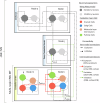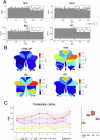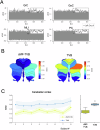Region-specific mean field models enhance simulations of local and global brain dynamics
- PMID: 40555720
- PMCID: PMC12187921
- DOI: 10.1038/s41540-025-00543-9
Region-specific mean field models enhance simulations of local and global brain dynamics
Abstract
Brain dynamics can be simulated using virtual brain models, in which a standard mathematical representation of oscillatory activity is usually adopted for all cortical and subcortical regions. However, some brain regions have specific microcircuit properties that are not recapitulated by standard oscillators. Moreover, magnetic resonance imaging (MRI)-based connectomes may not be able to capture local circuit connectivity. Region-specific models incorporating computational properties of local neurons and microcircuits have recently been generated using the mean field (MF) approach and proposed to impact large-scale brain dynamics. Here, we have used a MF of the cerebellar cortex to generate a mesoscopic model of the whole cerebellum featuring a prewired connectivity of multiple cerebellar cortical areas with deep cerebellar nuclei. This multi-node cerebellar MF was then used to substitute the corresponding standard oscillators and build up a cerebellar mean field virtual brain (cMF-TVB) for a group of healthy human subjects. Simulations revealed that electrophysiological and fMRI signals generated by the cMF-TVB significantly improved the fitness of local and global dynamics with respect to a homogeneous model made solely of standard oscillators. The cMF-TVB reproduced the rhythmic oscillations and coherence typical of the cerebellar circuit and allowed to correlate electrophysiological and functional MRI signals to specific neuronal populations. In aggregate, region-specific models based on MF and pre-wired circuit connectivity can significantly improve virtual brain simulations, fostering the generation of effective brain digital twins that could be used for physiological studies and clinical applications.
© 2025. The Author(s).
Conflict of interest statement
Competing interests: The authors declare no competing interests.
Figures







Similar articles
-
Cost-effectiveness of using prognostic information to select women with breast cancer for adjuvant systemic therapy.Health Technol Assess. 2006 Sep;10(34):iii-iv, ix-xi, 1-204. doi: 10.3310/hta10340. Health Technol Assess. 2006. PMID: 16959170
-
Immunogenicity and seroefficacy of pneumococcal conjugate vaccines: a systematic review and network meta-analysis.Health Technol Assess. 2024 Jul;28(34):1-109. doi: 10.3310/YWHA3079. Health Technol Assess. 2024. PMID: 39046101 Free PMC article.
-
Behavioral interventions to reduce risk for sexual transmission of HIV among men who have sex with men.Cochrane Database Syst Rev. 2008 Jul 16;(3):CD001230. doi: 10.1002/14651858.CD001230.pub2. Cochrane Database Syst Rev. 2008. PMID: 18646068
-
Home treatment for mental health problems: a systematic review.Health Technol Assess. 2001;5(15):1-139. doi: 10.3310/hta5150. Health Technol Assess. 2001. PMID: 11532236
-
Assessing the comparative effects of interventions in COPD: a tutorial on network meta-analysis for clinicians.Respir Res. 2024 Dec 21;25(1):438. doi: 10.1186/s12931-024-03056-x. Respir Res. 2024. PMID: 39709425 Free PMC article. Review.
References
-
- Arbib, M. A. Spanning the levels in cerebellar function. Behav. Brain Sci.19, 434–435 (1996).
-
- Sanz-Leon, P., Knock, S. A., Spiegler, A. & Jirsa, V. K. Mathematical framework for large-scale brain network modeling in The Virtual Brain. Neuroimage111, 385–430 (2015). - PubMed
-
- Breakspear, M. Dynamic models of large-scale brain activity. Nat. Neurosci.20, 340–352 (2017). - PubMed
MeSH terms
Grants and funding
LinkOut - more resources
Full Text Sources

